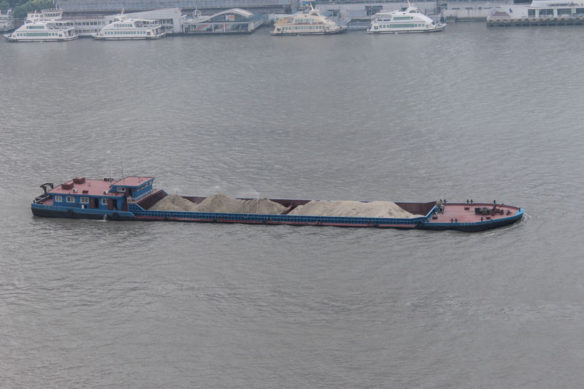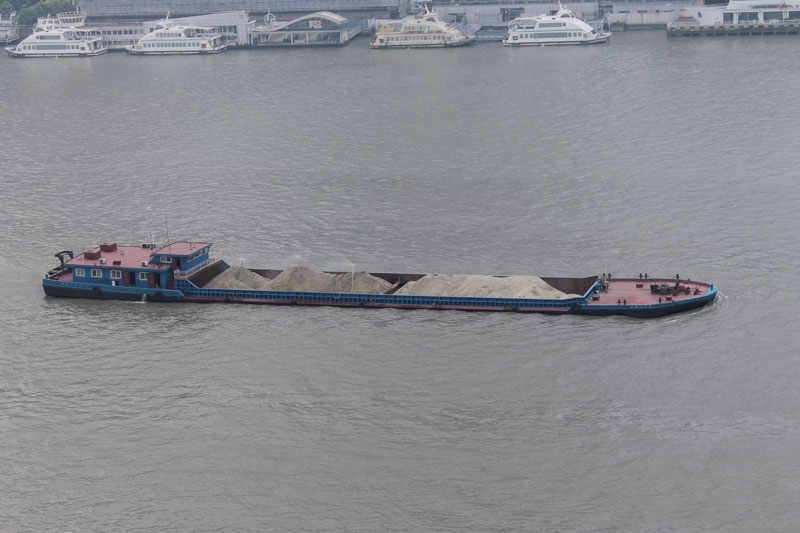
Sand barge. Photograph: © SAF — Coastal Care
As of 2011-2012, when investigative filmmaker Denis Delestrac and team, were first collecting and unveiling unpublished sand mining datas and information from the professionals involved, the Sand business was estimated to be a $70 billion industry, worldwide..
“Sand is the second most consumed natural resource, after water. The construction-building industry is by far the largest consumer of this finite resource. The traditional building of one average-sized house requires 200 tons of sand; a hospital requires 3,000 tons of sand; each kilometer of highway built requires 30,000 tons of sand… A nuclear plant, a staggering 12 million tons of sand…” Captions and Photograph by: “Sand Wars” Multi Award-Winning Filmmaker Denis Delestrac (©-2013).
Excerpts;
Cement is the second most-consumed resource in the world, with more than 4 billion tons of the material produced globally every year. As a result, the industry generates approximately 8 percent of global CO2 emissions, not far behind the agriculture industry, which accounts for 12 percent. Ranked with CO2 emissions from individual countries, the cement industry would be the third-highest emitter after China and the United States.
Now, the Global Cement and Concrete Association (GCCA), which represents about 30 percent of total cement production capacity worldwide, is trying to change that. The London-based organization, founded in January 2018 to “drive advances in sustainable construction while demonstrating industrial sustainable leadership in cement and concrete manufacturing,” announced the industry’s first “Sustainability Guidelines” following the conclusion of the COP24 climate conference in Poland this December…
Read Full Article; Yale E360 (12-28-2018)
Sand Is in Such High Demand, People Are Stealing Tons of It, By Dave Roos; HowStuffWorks (03-06-2017)
As strange as it may sound, sand is one of the world’s hottest commodities. The global construction boom has created an insatiable appetite for sand, the chief ingredient for making concrete. The problem is that sand isn’t as abundant as it used to be. And when high demand and high value meets scarcity, you open the doors to smuggling…
Sand, Rarer Than One Thinks: A UNEP report (GEA-March 2014)
Despite the colossal quantities of sand and gravel being used, our increasing dependence on them and the significant impact that their extraction has on the environment, this issue has been mostly ignored by policy makers and remains largely unknown by the general public.
In March 2014 The United Nations released its first Report about sand mining. “Sand Wars” film documentary by Denis Delestrac – first broadcasted on the european Arte Channel, May 28th, 2013, where it became the highest rated documentary for 2013 – expressly inspired the United Nations Environment Programme (UNEP) to publish this 2014-Global Environmental Alert.
The Conservation Crisis No One Is Talking About, By John R. Platt, TakePart (09-21-2016)
Beaches around the world are disappearing. No, the cause isn’t sea-level rise, at least not this time. It’s a little-known but enormous industry called sand mining, which every year sucks up billions of tons of sand from beaches, ocean floors, and rivers to make everything from concrete to microchips to toothpaste…
Sand Wars, An Investigation Documentary, By Award-Winning Filmmaker Denis Delestrac (©-2013)
Is sand an infinite resource? Can the existing supply satisfy a gigantic demand fueled by construction booms? What are the consequences of intensive beach sand mining for the environment and the neighboring populations…? This investigative documentary takes us around the globe to unveil a new gold rush and a disturbing fact: the “Sand Wars” have begun…









